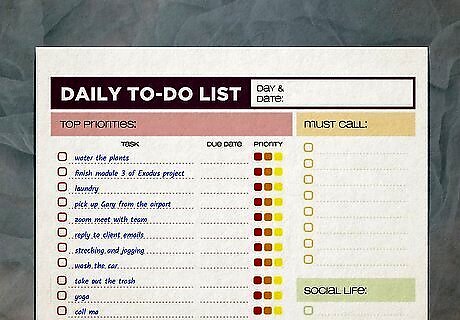
views
X
Trustworthy Source
PubMed Central
Journal archive from the U.S. National Institutes of Health
Go to source
Leading to stress, anxiety and frustration, this disorder can feel impossible to deal with. Understanding your unique experience of this debilitating disorder is the key to coping with it, beginning to achieve more and generally feeling less stressed.
Understanding pathological demand avoidance

Acknowledge an overwhelming or obsessional need to avoid demands. As a response to feeling overwhelmed, you will do whatever you can to avoid them. Watch out for this almost obsessional need to do tasks that don't inspire the feeling of high demand, doing anything to avoid these higher-pressure tasks.

Recognise the symptoms of PDA in childhood. If you have exhibited any of these traits as a child, you should ask your parents or caregivers whether they remember any of the following symptoms, as such is indicative of a PDA profile. One trait is excessive roleplay. They may pretend to be animals to get out of answering questions they know the answer to. A "do it myself" attitude regarding things they haven't learnt yet. This stubborn nature is typical in children with PDA. A child with PDA might only do things when they're motivated to do them. This can mask itself as being self-motivated and enthusiastic; however, when someone gives a task, they lose interest.

Pay attention to procrastination. A key feature in PDA, procrastination can take many different forms: putting things off until the last minute, not doing the laundry until there are no clean clothes left to wear, or excessive planning (which can help you avoid the actual task).

Identify triggers. Notice which types of demands make you anxious: is it direct instruction, sudden changes, or routines? Please keep track of these symptoms so you can cope with them better. Keep a journal outlining things you couldn't get yourself to do. Writing these things down will help you to recognise the types of demands which trigger your PDA.
Reducing external pressures

Give yourself choices. Create could-do lists to reframe your thinking as "I could do this" rather than "I have to do this". Having many options on the list is also a good idea, as accomplishing 1 or 2 items off a list is 100% better than not doing any of them.

Turn tasks into challenges. Set yourself time limits for tasks like cleaning or getting stuff done. Challenges can motivate you to do the task despite your tendency towards avoidance.

Take regular breaks. Breaks are crucial for your wellbeing and productivity. Introduce the Pomodoro technique to take set breaks at intervals. Prearranged break times are far better than self-regulating your breaks To implement this, set a timer for 25 minutes or so, then take a five-minute break to breathe or go for a walk. You can use apps and websites to try the Pomodoro technique.

Take things one at a time. Break down tasks into smaller, more achievable, bite-sized sections. You don't need to do it all at once; remember that. You're completing these tasks because you want to get them done; however, allowing yourself to break them down into steps will increase your chances of finishing the task. Write a list with sections on completing the task, making it clear and direct.
Coping mentally

Find calming techniques that work for you. Try deep breathing, listening to music, or using a fidget tool when anxious. Spend your time in a space where you feel calm and confident to engage in these techniques, such as a library, your bedroom, or outside in nature. More techniques you should try include: ] Physical exercise. Physical exercise is a proven method to improve mental health, so you shouldn't take it lightly, as its impact can be critical in enhancing one's wellbeing. Mindfulness techniques include different forms of meditation or mindful movement, such as yoga.

Use positive self-talk. Remember that it’s okay to struggle, and small steps are still progress. Try reframing your thoughts by changing "I'll never finish this" to "I'll try for a few minutes and see how I go from there".

Celebrate wins. Even getting started on a task is a great victory, so remind yourself not to be too harsh about productivity! Give yourself small sub-goals to work towards, each with breaks or rewards for finishing them.

Know when to seek professional help. Getting support from a therapist or OT may be necessary. An OT can help you work through daily task management tailored to your needs, as occupational therapists specialise in that.

Join support groups for PDA. There are many online groups which focus on PDA, which may have personal experiences from others like you, which can help you in your journey dealing with this disorder. Having support networks is vital to maintaining a healthy mindset with any disorder, and tips from those who understand may be more helpful than any tip in this article for specific issues you face.
Creating supportive routines

Make a flexible daily plan. Write down the things you want to do each day, but be okay with yourself if completing all of these steps isn't achievable. Use a visual schedule or checklist to track progress. Having everything you want to do in a day listed somewhere highly visible and clear to read will help remind you of them.

Involve things you enjoy. Don't forget to partake in hobbies that you enjoy to ensure you don't face burnout. Remember that doing things you enjoy is essential for your wellbeing, so make time to get involved in such activities daily.

Ask for help when needed. It may be difficult; however, asking for help with your routines can be important in getting the help you need. Remember, this is a debilitating disorder, and having someone to help you out completing tasks or just being there to body double you (be in the area as you complete tasks) can have an immensely positive impact.




















Comments
0 comment